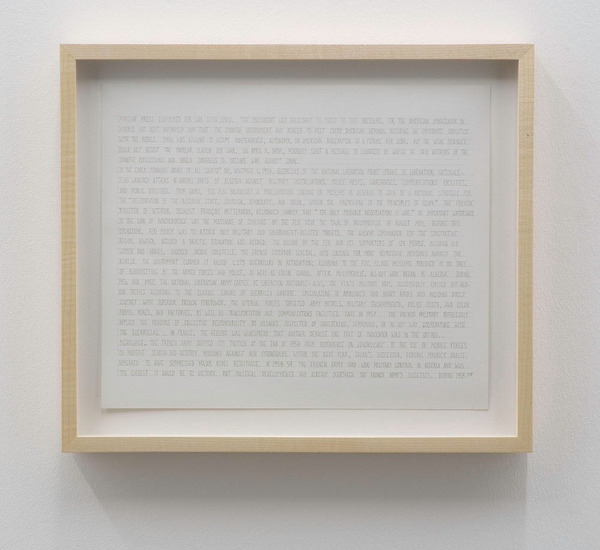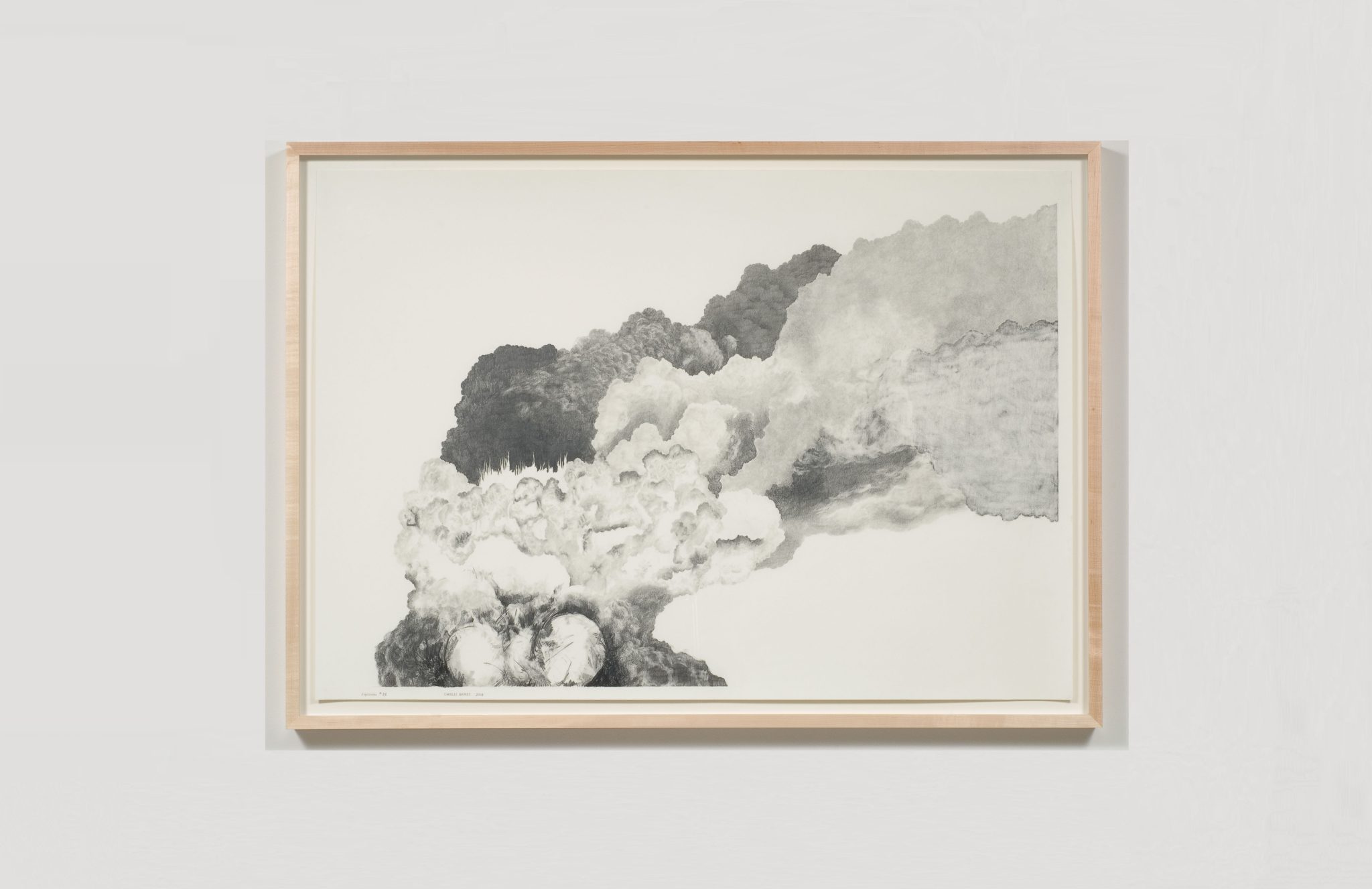Images

Charles Gaines: Drawings from the Explosion Series
Installation view
Installation view

Charles Gaines
Explosion # 22, 2008
Explosion # 22, 2008
Graphite on paper
Diptych, 30

Charles Gaines
Explosion # 23, 2008
Explosion # 23, 2008
Graphite on paper
Diptych, 30

Charles Gaines
Explosion # 24, 2008
Explosion # 24, 2008
Graphite on Paper
Diptych, 55

Charles Gaines
Explosion # 24, 2008
Explosion # 24, 2008
Graphite on Paper
Diptych, 55

Charles Gaines
History of Stars 4, 2007
History of Stars 4, 2007
C-Print mounted on aluminum
2 panels each 40

Charles Gaines
History of Stars 4
History of Stars 4
C-Print mounted on aluminum
2 panels each 40
Press Release
Susanne Vielmetter Berlin Projects is pleased to present a solo exhibition of new drawings by Charles Gaines. On view will be new drawings from his Explosion and from the Randomized Text series. In the larger context of his “Disaster Narratives, Gaines is interested in critiquing the way we experience art: in particular how we derive meaning and the experience of feeling from it. Gaines complex explorations attempt to reveal the political underpinnings of experiencing art by focusing on the linguistic structures that form our ideas and feelings. Gaines argues that metaphors and metonyms trigger the feelings we experience when facing a work of art. Hence his text/image relationships are arbitrary, and this encourages us to form metaphoric or metonymic relationships in order to make meaning, even though we know these relationships are not real. Feeling, therefore, is a cognitive (intellectual) judgment that employs our senses, rather than the autonomous function usually attributed to the aesthetic experience. Cognitively, we are unable to separate our senses from our knowledge of the world. Therefore, if we choose to call our sensible experiences aesthetic, we must have an idea of what something is (not what something means) before we can know if it is beautiful
Gaines describes the Explosion drawings as follows:
The idea for the Explosion series came to me after I made the machine-sculpture “Airplanecrashclock” in 1997. That work was a continuous repetition of an airline crash occurring as part of a construction of a downtown city scene. I got the idea for the series after constructing the crash scene. About 5 years later, I made two large works, Airplanecrash 1 and 2, drawings of plane crashes at the point of impact. The present series of “Explosion drawings focuses on the explosion itself without reference to a specific event or accident. However, accompanying the drawing is a small text drawing, an appendix that describes an anti-colonialist insurgency or a war of independence. My interest in the social context of the accident remained, but the text/image relationship is intended to form a montage rather than be an illustration. Although the appendix is a political contextualization, the drawing as a whole is a clear pastiche of unrelated subjects, webbing the aesthetics of the drawings with political history.
In Randomized Text: History of Stars, photographs of the night sky are paired with handwritten texts of sentences from two books, Love in the Time of Cholera, by Gabriel Garcia Marquez, and Orientalism, by Edward Said. The sentences are chosen based on a randomizing system in which alternate sentences from each book are combined according to the letter of the first word in a previous sentence. The result is a text whose actual meanings remain arbitrary in relation to the sequence of the sentences (the system) that produced them.
The conflation of arbitrary relationships in both Explosion and Randomized Text is what really underlies the illusion of pathos in representation, thus revealing the rhetorical level of discourse. It is the gap between content and the form of its representation that produces this pathos and sense of reality. Usually, when there is symmetry between form and expression, we are convinced that this is proof of the reality and truthfulness of the discourse and/or the image. But by arbitrarily combining them, I want to show the fallacy at the heart of our ideas about reality; rather than being based in truth, the real is a political (cultural) construction.
Charles Gaines, 2006
Charles Gaines work has been featured recently in the Venice Biennale, Venice, Italy; in a two person exhibition with Edgar Arceneaux at the RedCat Gallery, Los Angeles and at the Lentos Kunstmuseum in Linz, Austria. His work has been shown in solo exhibitions at Triple Candie, New York; Luckman Fine Art Gallery California State University, Los Angeles; Walter/McBean Gallery, San Francisco Art Institute, San Francisco; Santa Monica Museum, Santa Monica; Fresno Art Museum, Fresno, John Weber Gallery, New York City, Leo Castelli Gallery, New York City, and at Margo Leavin Gallery, Los Angeles, among others. He has been included in Double Consciousness: Black Conceptual Art Since 1970″, Contemporary Arts Museum, Houston; in Fade (1990-Present): African American Artists in Los Angeles, Luckman Gallery, Cal State LA; Recherche-entdeckt! Bilderarchive der Unsichtbarkeiten, Sixth Esslingen International Photo Triennial, Galerie der Stadt Esslingen am Neckar, Germany; Structure of Difference: Painting, Sculpture, and Photography of the Past 50 Years, Wadsworth Atheneum, Hartford; Deep Distance-Die Entfernung der Fotografie, Kunsthalle Basel; in More than Meets the Eye: Triennale der Photographie, Deichtorhallen, Hamburg; “Some Grids: The Grid in Twentieth Century Art,” Los Angeles County Museum of Art LACMA; “New Dimensions in Drawing, 1950-1980,” Aldrich Museum of Contemporary Art, Ridgefield; and in the “Whitney Biennial,” Whitney Museum of American Art, New York.
For images and press material, please contact Tobias Vielmetter at [email protected]. Susanne Vielmetter can be reached at [email protected].
Susanne Vielmetter Berlin Projects is located at Holzmarktstrasse 15/18 in Berlin Mitte. From the U/S train stop Jannowitzbrcke turn right and walk approximately 300 meters towards the Aral gas station. At the Aral gas station turn right towards the galleries which are located in the arched spaces underneath the rail road tracks. Gallery hours are Tuesday Saturday from 11 am 6 pm.
Wir freuen uns, eine Einzelausstellung mit neuen Zeichnungen von Charles Gaines zu prsentieren. Gezeigt werden neue Zeichnungen aus der Explosion und der Randomized Text Serie. Im weiteren Kontext seiner Disaster Narratives mchte Gaines kritisch reflektieren, wie Kunst wahrgenommen wird, insbesondere, wie aus Kunst Bedeutung erschlossen wird und Gefhle durch sie erlebt werden.
Gaines vertritt die Meinung, dass Metaphern und Metonyme die Ursache fr die Gefhle darstellen, die wir beim Betrachten von Kunst empfinden. Daher sind seine Text/Bild Beziehungen willkrlich, was den Betrachter dazu anregt, metaphorische und metonymische Beziehungen herzustellen um eine Bedeutung zu erlangen, obwohl wir wissen, dass diese Beziehungen in Wirklichkeit nicht bestehen. Demzufolge ist Gefhl eher das Ergebnis einer kognitiven (intellektuellen) Beurteilung, die unsere Sinne anregt, als eine unabhngige Funktion, die normalerweise auf die sthetische Erfahrung zurckgefhrt wird. Auf geistiger Ebene sind wir nicht in der Lage, unsere Sinne von unserem Weltwissen zu trennen. Daher mssen wir, wenn wir unsere gefhlsmigen Erfahrungen als sthetisch bezeichnen wollen, eine Vorstellung davon haben, was etwas ist (nicht, was etwas bedeutet) bevor wir wissen knnen, dass es schn ist.
Gaines beschreibt die Explosion Drawings wie folgt:
Die Idee zu den Explosion Drawings kam mir, nachdem ich 1997 die Maschinenskulptur Airplanecrashclock gemacht hatte. Diese Arbeit war eine kontinuierliche Wiederholung eines Flugzeugabsturzes, der sich als Teil einer Konstruktion eines Schauplatzes in einem Stadtzentrum ereignete. Ich bekam die Idee fr diese Serie, nachdem ich die Absturzszene gestaltet hatte. Etwa fnf Jahre spter machte ich zwei groe Arbeiten, Airplanecrash 1 und 2, Zeichnungen von Flugzeugabstrzen zum Zeitpunkt des Aufpralls. Die aktuelle Serie Explosion Drawings entstand mit dem Augenmerk auf die Explosion selbst, ohne Bezug auf ein spezifisches Ereignis oder einen spezifischen Unfall. Allerdings wird die Zeichnung von einer kleinen Textzeichnung begleitet, einem Appendix, der einen antikolonialistischen Aufstand oder einen Unabhngigkeitskrieg schildert. Mein Interesse an dem sozialen Kontext des Unfalls blieb bestehen, jedoch beabsichtigte ich mit der Text/Bild Beziehung vielmehr, eine Montage anstatt einer Illustration zu bilden. Obwohl der Appendix eine politische Kontextualisierung darstellt, ist die Zeichnung als Ganzes eine klare Nachahmung zusammenhangsloser Subjekte, die die sthetischen Aspekte der Zeichnung mit Politikgeschichte verwebt. In Randomized Text: History of Stars werden Fotografien des Nachthimmels mit handgeschriebenen Texten paarweise angeordnet. Die Stze stammen aus zwei Bchern, Die Liebe in den Zeiten der Cholera von Gabriel Garcia Marquez und Orientalismus von Edward Said. Die Stze wurden nach einem willkrlichen System ausgewhlt, innerhalb dessen alternierende Stze aus jedem Buch in bereinstimmung mit dem Anfangsbuchstaben des ersten Wortes aus einem vorhergehenden Satz kombiniert wurden. Daraus entstand ein Text, dessen eigentliche Bedeutungen beliebig in Beziehung zu der Satzfolge (des Systems) bestehen bleibt, die sie erzeugt hat. Sowohl in Explosion als auch in Randomized Text ist die Verschmelzung arbitrrer Beziehungen das, was der Illusion des Pathos in einer Darstellung wahrlich zu Grunde liegt und somit die rhetorische Ebene des Diskurses offenlegt. Es ist die Diskrepanz zwischen Inhalt und Form seiner Darstellung, die diesen Pathos und Realittssinn herstellt. Wenn Symmetrie zwischen Form und Ausdruck besteht, sind wir normalerweise davon berzeugt, dass dies das Ergebnis eines realittsgetreuen und wahrhaftigen Diskurses und/ oder Bildes ist. Doch indem ich sie beliebig kombiniere, mchte ich den Trugschluss ber die Realitt im Innersten unserer Vorstellungen darlegen. Die Wirklichkeit ist vielmehr eine politisch-kulturelle Konstruktion, als eine, die auf der Wahrheit basiert.
Gaines 2006
Die Arbeiten von Charles Gaines wurden vor kurzem bei der Venedig Biennale in Venedig, Italien, ausgestellt; auerdem bei einer Doppelausstellung mit Edgar Arcenaux in der RedCat Gallery, Los Angeles und im Lentos Kunstmuseum in Linz, sterreich. Die Reihe seiner Einzelausstellungen beinhaltet unter anderem: Triple Candie, New York; Luckman Fine Art Gallery; California State University, Los Angeles; Walter/ McBean Gallery, am San Francisco Art Institute, San Francisco; Santa Monica Museum, Santa Monica; Fresner Art Museum, Fresno; John Weber Gallery, New York City, Leo Castelli Gallery, New York City, Margo Leavin Gallery, Los Angeles
Er war an folgenden Ausstellungen beteiligt: Double Consciousness: “Black Conceptual Art Since 1970”, Contemporary Arts Museum, Houston; in Fade (1990-Present): African American Artists in Los Angeles, Luckman Gallery, Cal State LA; Recherche-entdeckt! Bilderarchive der Unsichtbarkeiten, Sixth Esslingen International Photo Triennial, Galerie der Stadt Esslingen am Neckar, Germany; Structure of Difference: Painting, Sculpture, and Photography of the Past 50 Years, Wadsworth Atheneum, Hartford; Deep Distance-Die Entfernung der Fotografie, Kunsthalle Basel; in More than Meets the Eye: Triennale der Photographie, Deichtorhallen, Hamburg; “Some Grids: The Grid in Twentieth Century Art,” Los Angeles County Museum of Art, LACMA; “New Dimensions in Drawing, 1950-1980,” Aldrich Museum of Contemporary Art, Ridgefield; and in the “Whitney Biennial,” WhitneyMuseum of American Art, New York.
Bilder und Pressematerial erhalten Sie von Tobias Vielmetter unter [email protected]. Susanne Vielmetter kann unter [email protected] erreicht werden.
SUSANNE VIELMETTER BERLIN PROJECTS befindet sich in der Holzmarktstrae 15-18 in Berlin Mitte, direkt neben c/o Atle Gerhardsen. Von der U/S Bahn-Haltestelle Jannowitzbrcke gehen Sie 300 Meter nach rechts bis zur Tankstelle. Die Galerien liegen rechts hinter der Tankstelle unter den S-Bahn-Bgen. ffnungszeiten sind Dienstag bis Samstag von 11 bis 18 Uhr.
